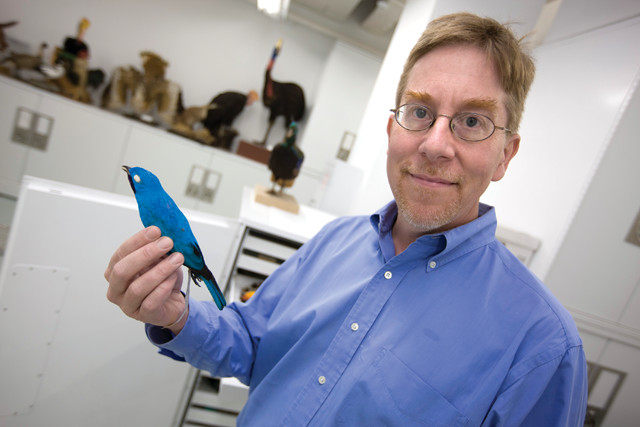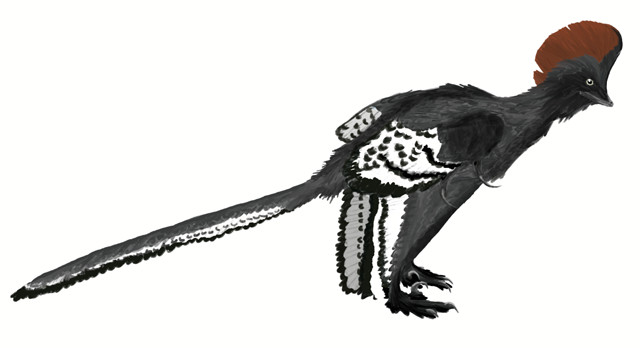
by Sam Lemonick Tuesday, November 14, 2017

Richard Prum studies modern birds to learn more about dinosaurs. Credit: John D. and Catherine T. MacArthur Foundation.
Prum, a professor of ornithology at Yale University in New Haven, Conn., was an avid birdwatcher as a kid and thought he might grow up to be a park ranger. But in college he became interested in phylogenetics — the study of evolutionary relationships. Combining that with his interest in birdwatching seemed natural, he thought. So he went into evolutionary ornithology.
Recently, Prum spoke with freelance writer Sam Lemonick about some of his biggest discoveries and how he hopes to change the way we think about birds and dinosaurs.
SL: How do you think of your work as a whole?
RP: I am an evolutionary ornithologist. That means I do a whole lot of different research on avian diversity that focuses on understanding how birds got to be the way they are in terms of diversity, structure, form and function, and even behavior. The one thing that I really am not is an ecologist. I’m not so much interested in the energy flow in the ecosystem or where birds are feeding. But just about everything else besides primary ecology is fair game.
SL: You are technically an ornithologist, but a lot of people know you as a dinosaur guy.
RP: Well, I am a dinosaur guy, and what I really hope to do is transform people’s opinions about what that means. For most people, a “dinosaur guy” wears a string tie and a cowboy hat and spends most of his time on his knees in the American West, digging up bones from 60 million to 100 million years ago. But dino guys also wear binoculars and go to the jungle to study behavior, feather function, feather evolution and development. Given that birds are dinosaurs, I am actually thoroughly a bird biologist. But the fact that birds are dinos makes me a dino guy.
My forays into paleontology — where I’m actually looking at the fossil evidence of the origins of feathers or dinosaur feathers — are a relatively small component of the work I do.

Prum and his colleagues recently described the plumage of Anchiornus huxleyi. Credit: Matt Martyniuk.
SL: One of your biggest contributions has been to our understanding of the origin of feathers. Where did they come from?
RP: With the discovery of Archaeopteryx [in the 1860s], it was clear that feathers evolved before modern birds were completely “bird-y.” Archaeopteryx had a mixture of what we considered at that time to be avian and reptilian forms, but it had entirely modern feathers. Until the late 1990s, the fossil record revealed nothing about the origin of feathers. For all that time, the process of trying to figure out how feathers originated consisted of extrapolating backward from modern feather diversity to some [hypothetical] antecedent or ancestral structure. We had to imagine what primitive feathers might have looked like.
For most of the 20th century, [we thought] that feathers were so exquisitely adapted for flight that they must have evolved through selection for aerodynamic function. Because of a general developmental relationship or similarity between feathers and scales, we thought that feathers actually evolved from elongate scales that were getting longer and longer to catch air.
[Since then, we have learned that] one of the most fascinating and complicated things about feathers is how they grow. The conundrum of feathers is that they’re branched like a tree, but grow from their base like a hair. That means that the branches are older than the trunks. I proposed that the elongate-scale model should be rejected because it is not sustainable or supportable. Feathers are tubular. What was going on was a series of specializations in the growth of this novel tube. The first feather that would have grown would have been tubular. The second feather would have been a tuft, where you subdivide the tube vertically to make a tuft growing out of a tubular follicle. Then subsequent of that would have been specializations in how the subdivisions of the tube grow to create barbed structures or branched structures.
Lo and behold, the short story is that [my idea] was confirmed by discoveries of feathered dinosaurs in the Liaoning [Province] in China and by molecular development work we did.
Now, with an abundance of new fossil feathers from Liaoning and elsewhere, we know that feathers evolved in theropod dinosaurs long before the origin of flight or the origin of modern birds, and that they evolved in their nearly complete structural diversity prior to the evolution of flight.
SL: How does this change our view of dinosaurs?
RP: This transforms our concept of what some of our most familiar dinosaurs were actually like. The fact that Velociraptor was fully plumaged when it chased the kids around the kitchen in “Jurassic Park” is transformative! It still hasn’t sunk in to popular culture that, for instance, T. rex was feathered to some extent. I think we’ve only begun to absorb this revolution in the popular culture and it’s certainly been a joy to be involved in that.
SL: What project is getting your attention right now?
RP: We’re working a lot on the physics of bird colors and blue bird feathers: how birds like blue jays and bluebirds make their color and in particular how those feathers grow. It turns out those colors are called structural. They are produced by optical interactions between ambient light and tiny little air bubbles — nanoscale air bubbles in the feathers. Those air bubbles have to be exactly the right size to make the appropriate color. Differences in blues are made by absolutely precise control of the size of individual air bubbles down to 10 nanometers, or a few millionths of an inch — really, really tiny spacing. It turns out the process of feather growth is a lot like bubbles in beer, or oil and water unmixing. It’s a form of phase separation.
SL: You’ve also done work on fossil feather color, right?
RP: A grad student [at Yale] in geology named Jakob Vinther was working on fossil squid from the Ordovician, and it turns out that in the fossils you can see the squid ink beautifully preserved. Squid ink is made of melanosomes — tiny little organelles packed with melanin pigment, which are what produce black or red hair in humans. Jakob found out that these melanosomes fossilize beautifully in squid. He was very interested in contacting me about pursuing these in feathers. We started looking at fossil feathers and discovered that the melanosomes in feathers do fossilize. In fact, people had noticed these objects going back into the 1960s and ‘70s, but they [thought they were] bacteria that had eaten the feathers at the time of fossilization.
The next step was to realize that modern bird feathers have two different kinds of melanin: eumelanin, which makes black colors, and phaeomelanin, which makes red-browns. These melanosomes are different sizes and shapes. So, using that idea, we were able to reconstruct the plumage color on a very interesting dinosaur called Anchiornus huxleyi. It had a mostly gray, blackish body, with an elongate crest of rufous [reddish-brown] feathers, and long white feathers with black tips that formed an incredibly bold pattern on the arms and legs.
One of the exciting things for me as a birdwatcher was having a scientific opportunity to write a field guide-like description of the actual plumage of an actual dinosaur that’s been extinct for 150 million years. I get goosebumps just thinking about it.
© 2008-2021. All rights reserved. Any copying, redistribution or retransmission of any of the contents of this service without the expressed written permission of the American Geosciences Institute is expressly prohibited. Click here for all copyright requests.